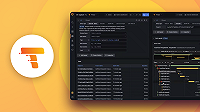Enable service graphs
Service graphs are generated in Tempo and pushed to a metrics storage. Then, they can be represented in Grafana as a graph. You will need those components to fully use service graphs.
Note
Cardinality can pose a problem when you have lots of services. To learn more about cardinality and how to perform a dry run of the metrics generator, see the Cardinality documentation.
Enable service graphs in Tempo/GET
To enable service graphs in Tempo/GET, enable the metrics generator and add an overrides section which enables the service-graphs generator.
For more information, refer to the configuration details.
To enable service graphs when using Grafana Agent, refer to the Grafana Agent and service graphs documentation.
Enable service graphs in Grafana
Note
Since Grafana 9.0.4, service graphs have been enabled by default. Prior to Grafana 9.0.4, service graphs were hidden under the feature toggletempoServiceGraph.
Configure a Tempo data source’s service graphs by linking to the Prometheus backend where metrics are being sent:
apiVersion: 1
datasources:
# Prometheus backend where metrics are sent
- name: Prometheus
type: prometheus
uid: prometheus
url: <prometheus-url>
jsonData:
httpMethod: GET
version: 1
- name: Tempo
type: tempo
uid: tempo
url: <tempo-url>
jsonData:
httpMethod: GET
serviceMap:
datasourceUid: 'prometheus'
version: 1

